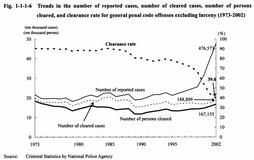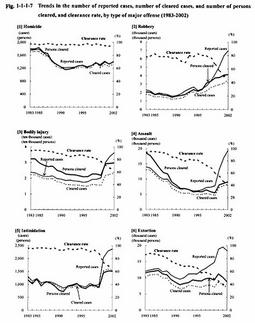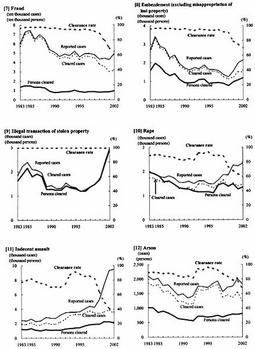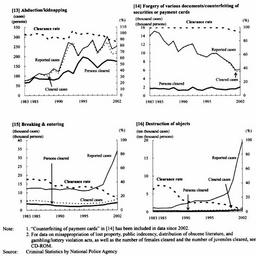| Previous Next Index Image Index Year Selection | |
|
|
2 Trends in general penal code offenses excluding larceny This subsection reviews the trends in general penal code offenses other than larceny. Fig. 1-1-1-6 shows the trends in the number of reported cases, number of cleared cases , number of persons cleared, and clearance rate for general penal code offenses excluding larceny over the last 30 years.
The number of cleared cases had almost leveled off since 1995, but it increased successively in 2001 and 2002, reaching 188,809 in 2002, the highest level since 1989. The number of persons cleared has also been on the rise, reaching 167,155 in 2002, the highest level since 1975. Nevertheless, the clearance rate has declined, falling below 40% in 2002 for the first time after the war. The number of reported cases for general penal code offenses excluding larceny, has increased remarkably, and in particular, has rapidly risen by more than 20% from the previous year for 3 years since 2000. Therefore, the number of cleared cases could not keep up with such a high pace. This is one of the reasons that the clearance rate fell sharply. Fig. 1-1-1-6 Trends in the number of reported cases, number of cleared cases, number of persons cleared, and clearance rate for general penal code offenses excluding larceny (1973-2002) Fig. 1-1-1-7 shows the trends in the number of reported cases, number of cleared cases, number of persons cleared, and clearance rate for major penal code offenses over the last 20 years (see Appendix 1-2 and 1-3 ).The reported cases for homicide leveled off or slightly increased after a lengthy downward trend. In 2002, they reached 1,396, the highest level over the last 10 years. The clearance rate for homicide has remained high, at somewhere between 94% and 99%, a rate rarely seen in other nations. In recent years, the number of reported cases has shown remarkable increase and the clearance rate has sharply fallen for other nine types of violent offenses-robbery, bodily injury, assault, intimidation, extortion, rape, indecent assault, breaking and entering, and destruction of objects. This trend was also seen in 2002, except for the recovery in the clearance rate for robbery to over 50% and the decrease in the number of reported cases of extortion. On the other hand, the clearance rate has remained relatively high for intellectual crimes such as fraud, embezzlement (excluding misappropriation of lost property), and forgery / counterfeiting, etc. Fig. l-1-1-7 Trends in the number of reported cases, number of cleared cases, and number of persons cleared, and clearance rate, by type of major offense (1983-2002) |



